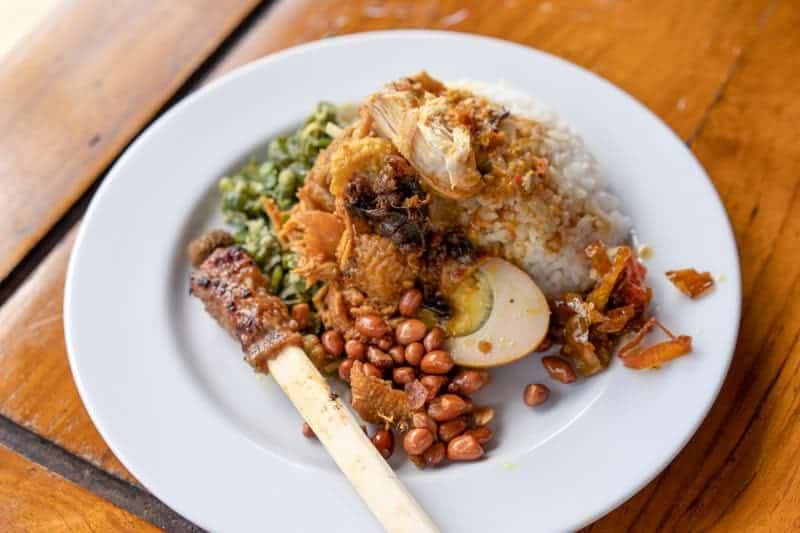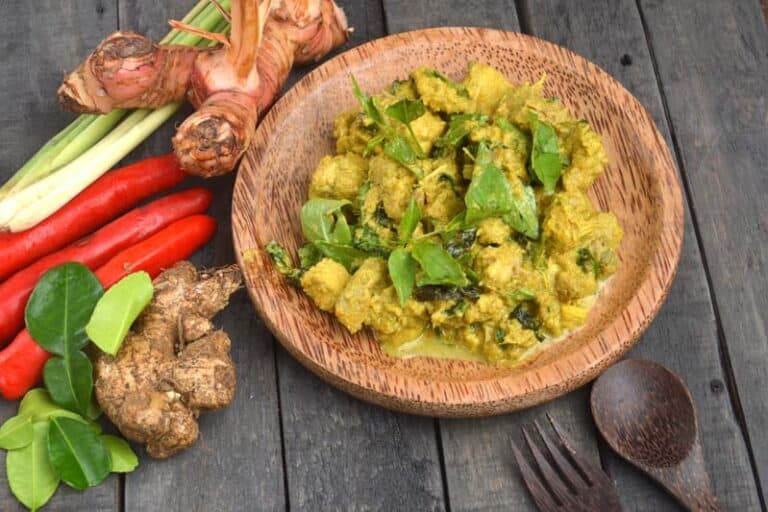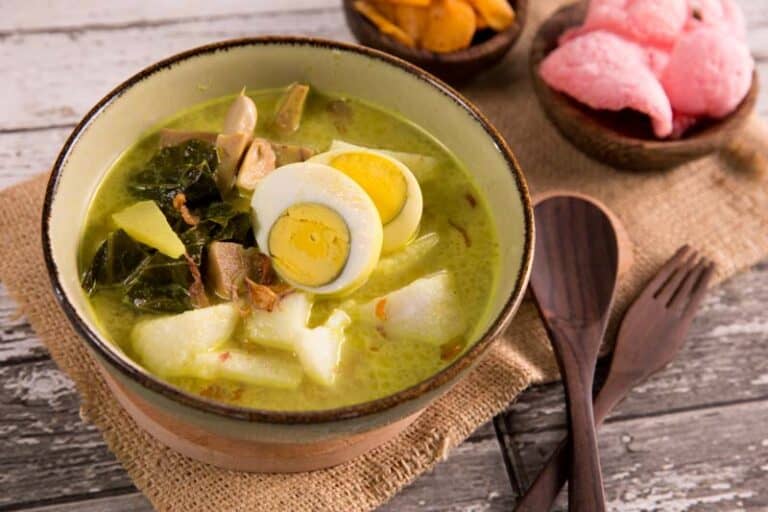Bali has more than nature and culture to offer. The authentic taste of Balinese spices is reflected in its traditional Balinese food that can originally be found around the island. Here are some of the best authentic Balinese food and cuisine you should try. Please bear in mind that some of them can be (too) spicy for some of you.
Satay lilit
In Indonesia in general, satay itself is usually referred to as the grilled skewered meat on sticks. But in terms of Balinese food, Bali has more specific satay called satay lilit, which is the minced fish or chicken mixed with some spices, grated coconut, and coconut milk, then wrapped around the (lemongrass, bamboo, or sugarcane) sticks and grilled over the charcoal or open fire –tastes delicious between slightly spicy, savory, and sweet.
Babi guling
Babi guling, or also known as suckling pig, is one of the most iconic Balinese food and dishes you can find. It is basically whole roasted pork stuffed and greased with the mixture of traditional spices and paste, cooked over the coal fire or burning coconut husks from hours with slow-roasting process resulting in a crispy skin, tender and juicy meats. It is usually served with the rice, pork sausage, ‘sayur urap’, lawar, and the delicious savory soup.
Betutu
Betutu is basically a way of cooking for a slow-cooking smoked dish in a coal fire for 6-7 hours. A whole chicken or duck meat is rubbed and stuffed with a complex mixture of spices, then wrapped in palm leaves, then it’s smoked, baked, or steamed for hours – usually served with water spinach. It usually tastes very spicy, so make sure to ask about the level of spiciness before you put your order.
Lawar
Lawar is a typical Balinese food (meat) salad, usually consumed with babi guling or Balinese mixed rice. Red lawar is made by the chopped meat (either pork, chicken, duck, beef, or even dragonflies and turtles), with various vegetables (young jackfruit, grated coconut, or cassava leaves), chilies, spices, and fresh animal blood to add a particular savory flavor. If you are a vegetarian or do not prefer the meat and blood, instead, you can order a white lawar, which does not contain meat or blood.
Tum
Tum is leaf-wrapped meat (usually pork) bundles of highly-seasoned taste; it is minced pork mixed with some spices (such as garlic, shallots, chillis, bay leaves, gingers, lemongrass, coconut milk, chili, etc.) and wrapped with a banana leaf before being steamed or grilled. Tum is made using the Indonesian cooking method called pepes: banana leaf wrapping, which both ends are closed before being steamed.
Sambal Matah
Sambal matah is an authentic Balinese food of chili sauce made from finely chopped raw shallots, lemongrass, chili, lime, and cooked coconut oil – added with some salt, sugar, and a dash of shrimp paste. It can be literally served with any Balinese food, like Balinese mixed rice, babi guling, betutu, satay lilit, or even grilled fish or chicken – truly a Balinese favorite!
Nyat-nyat
Nyat-nyat is an authentic Balinese food cooking process through boiling the meat with Balinese herbs for 30 minutes and serving it with the mud texture – carrying out the medium spicy flavors. It can be cooked with any meats including pork, but the most favorite is to be cooked with fishes, particularly Mujair (tilapia) or Nila (Nile Tilapia) kinds of fish. It is one of the most authentic Balinese food you can find only in Bali.
Tipat
“Tipat” itself, or called “ketupat” in Indonesian, is a boiled rice cake packed in a diamond-shaped leaf, usually served as a replacement for rice – can be found in all over Indonesia. However, Bali has some authentic and special tipat dishes, such as tipat blayag (Buleleng original menu serving tipat with vegetables, fried chicken feet, shredded chicken, eggs, peanut, fried shredded coconut, soybeans, chili paste, chicken skin crackers, and chicken nyat-nyat sauce), and tipat cantok (steamed vegetables with peanut sauce served with tipat – similar to gado-gado). They are best enjoyed with “es gula” or ice syrup drink.
Rujak Bali
Rujak is one of the authentic Indonesian snacks. It is basically the fruit salad of sliced fresh fruits, like pineapple, cucumber, unripe mango, jicama, and even some pomelo. There are some various rujak combinations in Balinese food and dishes, such as rujak gula (originated from Buleleng, served with brown sugar sauce mixed with vinegar, shrimp paste, some chili); rujak kuah pindang (rujak served with infused fish boiled in spices and salt); rujak cuka (rujak served with a strong aroma of vinegar, sugar, and chili); rujak colek (rujak dipped in the red spicy and savory sauce); rujak bulung (similar to rujak kuah pindang, but served with seaweed instead of fresh fruits, sometimes added with some bean sprouts or noodles).
Jaje Bali
Jaje Bali is basically a Balinese food and sweets for dessert, usually can be found in the traditional markets. Jaje Bali consists of some traditional snacks called jaje kukus (steamed black glutinous rice), lukis (triangle-shaped sticky rice usually steamed and wrapped with banana leaves), pisang rai (steamed banana), laklak (rice flour and coconut milk cake), batun bedil (the boiled small, sticky rice and tapioca flour dumpling balls), kelepon (a small, olive dough ball dyed with green leaf juice), and giling-giling or cenil (the boiled long twisted red color starch) – all topped with grated coconut and palm sugar sauce cooked with pandan leaves.






